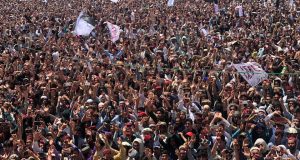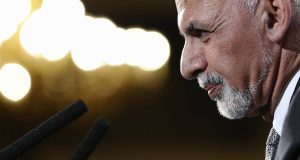On May 22, 2017, Pakistani band Khumariyaan performed to a packed theatre at Trinity College Dublin. Mr. Nasruddin Saljuqi, who is Chairperson of the Afghan Community of Ireland, was among the keynote speakers on the night. Mr. Saljuqi was born in Herat, Afghanistan in 1956. After completing his degree in literature at Kabul University, he worked in the Ministry of Telecommunication as a planning director. In 1989, he left Afghanistan because of war conflicts and went to Iran, where he taught for a year in an Afghan refugee school before being drafted into the administrative section of the Afghan General Consulate in Mashhad. He worked there for several years before relocating to Ireland with his family in 2000. Since his arrival in Ireland, Mr. Saljuqi has helped introduce Afghan culture to Irish society through the organistaion of several artistic and cultural events in Dublin and other parts of Ireland. As chairperson of the Afghan Community of Ireland, and a member of the Dublin regional forum of the Ministerial council on Migrant Integration, Mr. Saljuqi is actively involved in supporting Afghan refugees and asylum seekers and has attended many governmental and NGO conferences in Ireland and in other European countries. Furthermore, Mr. Saljuqi is the author of a number of artistic books and brochures, which have been published in Afghanistan, Iran and Ireland.
(Due to the limited time allocated to each speaker on the night, the following is a transcript of conversations between this scribe and Mr. Saljuqi carried out over the past month).
Merisi: Mr. Saljuqi, could you discuss Afghanistan’s long tradition of music and cultural exchange?
Nasruddin Saljuqi: Afghanistan has a long tradition of cultural exchange, particularlyin relation to music. Considering the fusion of ‘East and West’ realised in the music of Khumariyaan – partly through their mix of instruments such as guitar and rubab, it reminded me of the story of King Amanullah Khan. During the time of his reign in Afghanistan, he invited a group of Indian musicians accompanied by Indian lady dancers to play and dance at his palace and court, which in turn, influenced the music tradition in Afghanistan. Equally, western music also influenced Pakistani and Indian music. When we take for example the harmonium, most people think this instrument is historically and traditionally indigenous to Afghan, Pakistani and Indian culture. However, we also find similar western instruments such as the accordian and organ, which are equally considered part of the western musical tradition. The development and evolution of music therefore, cannot be claimed to any one region or race – in fact, musicians learn from each other. For example, one of my relatives, Allama Salahuddin Saljuqi – a Muslim religious scholar, wrote many books on the philosophy of Islam while he was Minister of Arts and Culture in Afghanistan around sixty years ago. Allama Salahuddin sent a group of students to the West in order to learn western music. Having returned, these students brought western music back to Afghanistan further teaching and training Afghan musicians in western styles.
Merisi: Could you discuss the musical instrument known as the ‘Rubab,’ which is traditionally considered by many to be the quintessential instrument of Pashtuns?
Nasruddin Saljuqi: The Rubab is made from the trunk of mulberry or walnut tree and its bowl is covered with goat skin. The Rubab comes in different sizes – large, medium and small. The length of the ordinary Rubab, which is called ‘Zilcheh,’ is 99cm and it is played with a plectrum. There are five main strings of different thickness, which are called “Shahtar,” meaning tricky string. There are 16 side truck metal strings fixed with 14 pegs and they are used for tuning. On the short neck of the Rubab four or five frets can be observed and gradually musicians could add more frets onto it. Researchers have different ideas about the origins of the Rubab. Some say it was invented more than 5000 years before Christ. Many argue that the word ‘Rubab’ is taken from (Ravanastron) King of Sylan, and after some time,the word changed from Ravana to Raavveh. Another researcher says it is a Hebrew word (Lype), after which the letter L changed to R. According to another opinion, it is a Persian word that was taken from (Rab) and Rababeh. Rab in Arabic means additional and most researchers have named it ( Ravaveh) which means sorrowful sound. Professor Fekri Saljuqi, a well known Afghan historian, painter, calligrapher and musician, used to play Rubab as a hobby. In an article called “Yesterday’s Lute and Today`s Mandolin,” he wrote that the instrument, which is famous in our country (Afghanistan) is not the original, historical Rubab. According to him, the ancient Rubab had a different shape and was played with plectrum by Greeks and with a bow by Aryans. Many Persian poets such as Saadi, Molawi, Ferdowsi, Hafiz, Shams Tabrizi , Farabi, Daqiqi and Balkhi give a good description of this instrument in their poems.
Moreover, there are hundreds of professional and mature Rubab players in Afghanistan. One of the most famous was Master Muhammad Omer who played on radio and TV in Afghanistan. In fact, Muhammad Omer trained many students from America and Europe and was contracted to teach the Rubab at Washington University. Among these foreign students of Rubab, is the well-known professor John Bailey, the renounced ethnomusicologist from Goldsmith University in London.
Merisi: You have written a book, which has been recently published in English, titled ‘From Danbura to Guitar: The Diaspora of Afghan Musicians.’ Could you briefly discuss this book:
Nasruddin Saljuqi: Firstly, the book outlines information concerning the instruments of Afghan music such as the rubab, dotar, tabla, wadz and chang, among many others. The book offers a brief description of the history of Afghan music as well as some biographies of musicians and singers in the Afghan diaspora.
One of the concepts behind this publication, was the aspiration to encourage Afghan immigrant musicians who were displaced during the war to build artistic relations among the Afghan Diaspora and also western musicians, and to give cultural awareness of diverse ethnic backgrounds to indigenous communities.
Merisi: It sounds like a wonderful book which I hope to review in the near future. Thank you for agreeing to this interview. I look forward to future discussions as well as your future writings and publications.
Nasruddin Saljuqi: You are very welcome. Thank you.
Angelina Merisi hails from Ireland. She is part of the Pashtuns Times’ Team. She has a BA degree in History of Art, MA in Study of Religions. She won a PhD scholarship for her research on Pashtun Culture and Society. She is currently on sabbatical. In the meantime, she continues writing and researching on Pashtun culture and society.
 Pashtun Times Latest News
Pashtun Times Latest News






